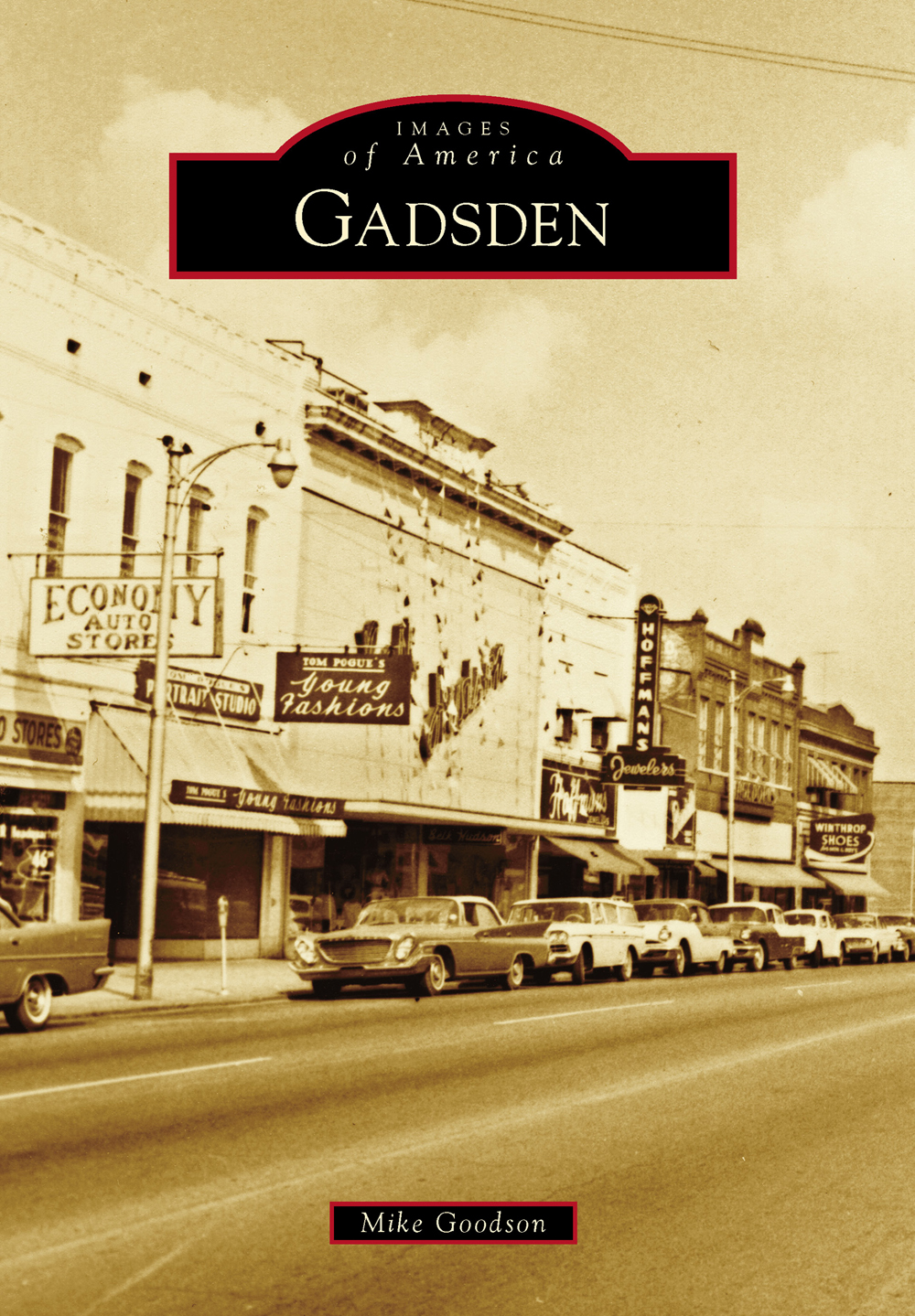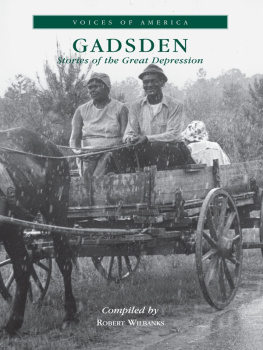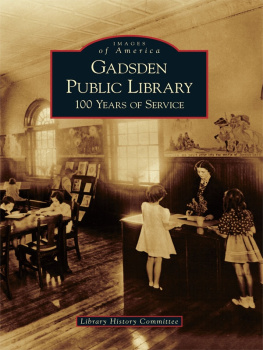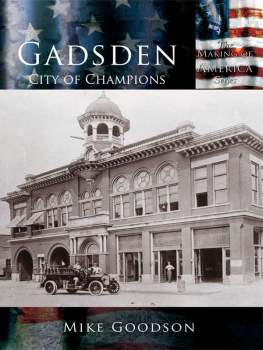
IMAGES
of America
GADSDEN
ON THE COVER: The downtown business district is shown here in its heyday of the late 1950s and early 1960s. Most businesses were located in this six-block area from First Street to Seventh Street. With the coming of the shopping centers and the Gadsden Mall, downtown soon began to take on the appearance of a ghost town. A major downtown revitalization would begin on Broad Street on May 15, 1998. Alabama governor Fob James, Gadsden mayor Steve Means, and several other city officials were on site for the ground-breaking for downtowns major face-lift. The plans called for a vast resurfacing project, wider sidewalks, old-fashioned street lamps, benches, and trees to adorn the landscape. The original plans called for the project to be completed within six months. Work began on May 26, 1998, in the 500 block of Broad Street with the removal of the top layers of the streets paving, which also exposed the streetcar tracks that had not been used since the streetcars made their final run during the early 1930s. (Authors collection.)
IMAGES
of America
GADSDEN
Mike Goodson

Copyright 2014 by Mike Goodson
ISBN 978-1-4671-1223-9
Ebook ISBN 9781439646786
Published by Arcadia Publishing
Charleston, South Carolina
Library of Congress Control Number: 2014942566
For all general information, please contact Arcadia Publishing:
Telephone 843-853-2070
Fax 843-853-0044
E-mail
For customer service and orders:
Toll-Free 1-888-313-2665
Visit us on the Internet at www.arcadiapublishing.com
This book is dedicated to the men and women of the city of Gadsden known as baby boomers. These people have helped our town to grow and make it a safe and pleasant place to live. These people went off to war and returned to a little better life because of the men, women, and children who went to work when the young men were off defending the freedom we hold so dear. This book is also dedicated to so many special friends who have offered encouragement to keep me busy. They have lifted me up when I was low, comforted me in times of sorrow, and kept me going when I felt as if I could not take one more step. To quote a special angel, No man is a failure who has friends.
CONTENTS
ACKNOWLEDGMENTS
The undertaking of the task of documenting local history has proven to be a labor of love for me for the past 15 years. This began as a love of vintage photographs and, later, a journey through the pages of the local newspapers. This journey has introduced me to many interesting people who have enhanced my love for local history. These are the people who founded this great city and their exploits, which helped a small stop on the riverboat route to grow into an industrial center in northeast Alabama.
A great debt is owed to the many local historians who have helped to record Gadsdens history in both written text and the lenses of the camera. A special thank-you is extended to Bob Scarboro who has always been kind to share his wonderful collection of photographs and his vast knowledge of local history. This debt of gratitude is also extended to the Odell Buffington and Adolph Lebourg families who recorded history with their cameras for many years.
While the great local photographers have captured many historical events in the life of everyday Gadsden, a special word of thanks is extended to the people of this great city. Through their encouragement, these books have become a reality. Over the past months, several people have helped me through stormy days and would not allow me to stop doing the thing that I love most, writing history. To these dear friends, I owe a great debt of gratitude. To my friends and church family, you kept me focused and would never let me consider giving in.
And last but never least, a thank-you goes to my dear sisters Glenda and Becky, who have kept me going with their great encouragement that helped to make this book a reality.
Unless otherwise noted, all images appear courtesy of the author.
INTRODUCTION
The city of Gadsden had humble beginnings as a stop on the riverboat line from Rome, Georgia, to Greenport, Alabama. The town was a vision of Gabriel Hughes and his brother Joseph Hughes. Although the settlement began to grow slowly in 1845, by the turn of the 20th century, the village was beginning to show the signs of a much larger city. By the days of the Great Depression the city was a thriving metropolis with major industries, professional athletic teams, and modern theaters. Gadsden would slowly begin to struggle during the hardships of the Great Depression years. This struggle would continue through the early days of World War II.
It was obvious the United States would not be able to remain neutral in the war in Europe. Frank Towers was a Gadsden police officer who walked a beat on Broad Street before reenlisting in the Navy just before the events that plunged the United States into World War II. On October 31, 1941, Towers was killed aboard the USS Reuben James when it was torpedoed off the coast of Iceland. The United States was closer to the latest war to end all wars. The inevitable came about on December 7, 1941, when Japan attacked the US naval installation at Pearl Harbor. Gadsden would join the war effort and send its sons and daughters into harms way to do their part.
In 1945, Pres. Harry Truman authorized the use of atomic weapons against Japan. The devastation was horrific, and Japan surrendered shortly after its second city was destroyed. Happy days were here again! The US troops slowly began to come home to their families and jobs. A time of prosperity followed as the country went from a wartime economy to a peacetime economy. Detroit was making cars once again, and families began to return to a normal life.
One of the businesses that would see a boom following the war was the motion picture industry. A downtown Gadsden icon was the Princess Theatre. The Princess Theatre was originally known as the Imperial Theatre when it opened on November 24, 1920. The first movie shown was The Right to Love, which starred Mae Murray and David Powell. A capacity crowd filled the 730 seats on opening night. The Imperial was the first real challenge to the Gadsden Theatre for the entertainment dollar in Etowah County.
In July 1926, the theater changed hands, and an extensive facelift took place, transforming the Imperial into the Princess Theatre. A balcony was added, as well as a vaudeville stage. The interior of the house was redecorated. The Princess opened on September 11, 1926, with the movie feature being The Phantom Bullet, starring Hoot Gibson. The Princess enjoyed a long and successful life until 1937, when plans were announced to remodel and enlarge the theater. The Princess reopened June 17, 1937, to a huge crowd in the totally rebuilt auditorium. The Princess Theatre, managed by D.B. Dixon, was the place to go in downtown Gadsden for many years.
The Princess enjoyed a very successful life until it was destroyed in a fire on November 4, 1963. At 10:48 p.m. on the night of the fire, Gadsden police officer Bill OBryant was walking his beat when he noticed what appeared to be a garbage can burning next to the theater.
OBryant turned in the alarm, and several fire engines answered the call. When the first trucks arrived, they found the theater engulfed in flames.
On September 26, 1947, a new movie house opened in Gadsden, and things took a drastic turn for local moviegoers. Gadsdens Pitman Theatre became the newest addition to downtown. This movie house was owned and operated by C.S. Pitman from Pine Mountain, Georgia.
Next page











